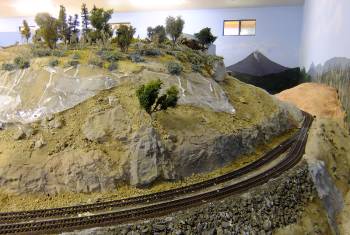
|
The placing of trees and brush began at the top of the mountain. Trees made by various club members were first drilled into the land form. Next brush made from leftover tree making material (aka furnace filter fiber) was sprayed gray, lightly flocked and glued down. Then came scrub trees made out of dried florist materials. Finally, ground foam of various textures and colors covered bare parts of the ground. A lot of white glue was used and so the plastic wrap was again inserted between the pop up and fixed scenery to prevent them from being stuck together. |
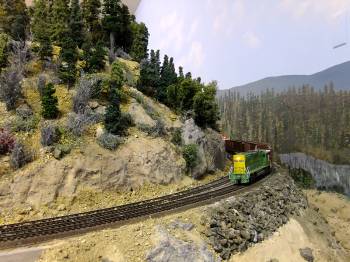
|
This process was repeated on down the mountain, all the way to the tracks. Eventually, we started running low on club-made trees and resorted to some commercially bought and club-modified trees. |
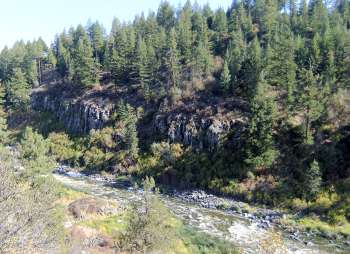
|
Back in Part 2, mention was made of the Palisades. This formation was discovered on the south side of the Klamath River and was visible only from the Weyco right of way. We decided this would be a most distinctive feature to include in the backdrop. Some consideration was given to modeling this rock formation in three dimensions, but in light of the fairly narrow space we'd allowed for this part of the scene, we decided to encourage John to paint the palisades on the wall. |
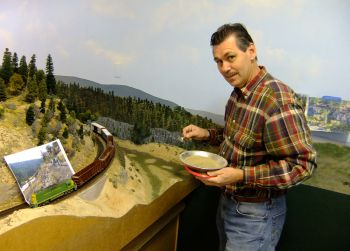 |
John It's Only Paint Gerritsma had long ago mastered the art of painting trees and hills on the backdrop. But, the Palisades provided a new challenge. An earlier, shorter version was determined to be too small and the backdrop was redone, working from photos taped to the wall.
Largely satisfied with the Palisades, John turns his attention to the Klamath River. After painting the plaster bottom various shades of green (the Klamath River has a LOT of algae in September), John spread sand and gravel along the bank and in the river. |
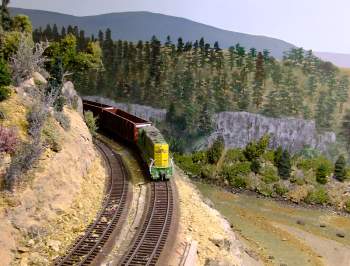 |
John and Larry then created the brushy bank between the river and the Palisades. A variety of materials were used here.
Club members had searched various archives, maps and other documents for a name for what we called either the Helix or the Keno Loop. Nowhere could we find a name representing this scene. Club President Dave Carr suggested we dub this area "Palisades" and one and all agreed this was what it should be named from now on. |
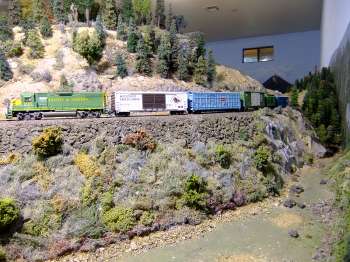
|
Then the area at the rear, below and to left of the tracks received a bunch of trees. Once they were in, Larry brushed up the embankment below the tracks, working small trees into the rock wall. It's September and much of the vegetation has lost it's leaves while other small trees are starting to turn color. Near the bank of the river, we noticed a narrow band of reddish brush.
Modeler's Note: None of the brush in this scene is available commercially. For the smaller brush, Larry gathered "trees beard" moss locally and painted, flocked, cut and glued it in place. |
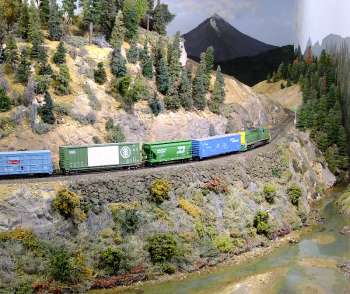 |
John and Larry finally poured Enviro-Tex to form the Klamath River. Next will be the white water so characteristic of this part of the river. But, for now, it's nice to look at some "wetness" at the bottom of the scene. |
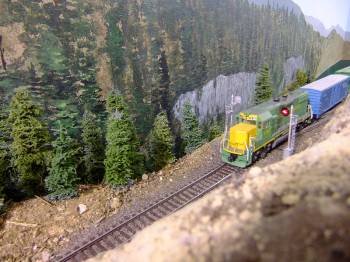
|
A "beauty shot" from the opposite direction. The camera is perched on the unfinished hillside. |
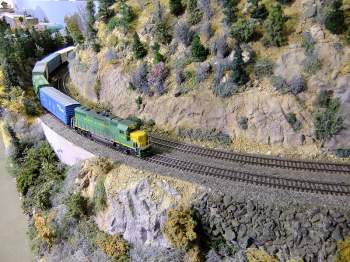
|
Trees and brush are continued around the bend to the left and ballast is finally installed. The dense forest in the upper left creates a view block for the Merganser industrial area just a few feet away. |
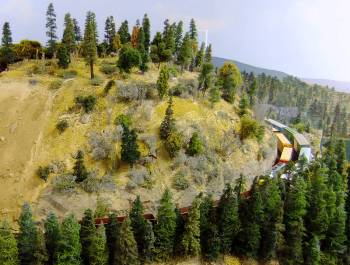 |
Another image of this mostly completed scene. Can you tell where the pop-up joins the fixed scenery now? (No, it's not the obvious line on the far left -- that's just where work on the scenery stopped.) |
 |
Building the scene on the back side. How to minimize the "spaghetti bowl" effect. |

